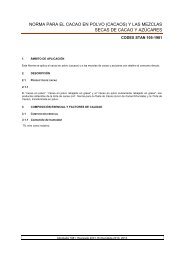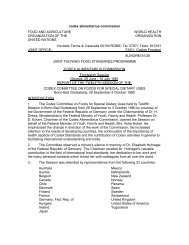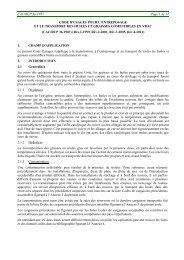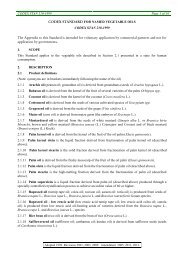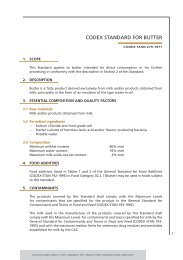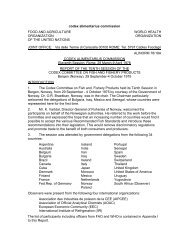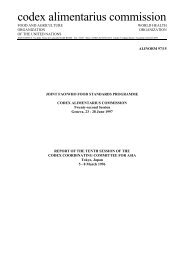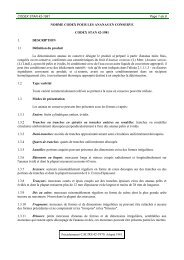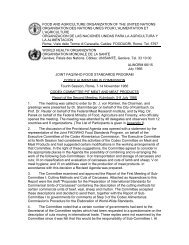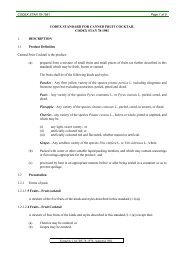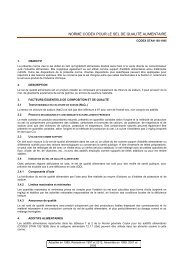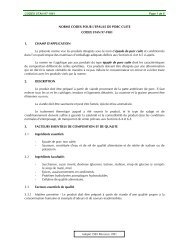REP13/FH JOINT FAO/WHO FOOD STANDARDS PROGRAMME ...
REP13/FH JOINT FAO/WHO FOOD STANDARDS PROGRAMME ...
REP13/FH JOINT FAO/WHO FOOD STANDARDS PROGRAMME ...
You also want an ePaper? Increase the reach of your titles
YUMPU automatically turns print PDFs into web optimized ePapers that Google loves.
<strong>REP13</strong>/<strong>FH</strong> Appendix IV 58<br />
SECTION 9 – PRODUCT INFORMATION AND CONSUMER AWARENESS<br />
9.4 Consumer education 4<br />
The following should be considered:<br />
All stakeholders – government, industry, consumer organizations and the media – should work<br />
together to communicate clear consistent messages on handling berries safely to avoid giving<br />
contradictory advice and causing confusion.<br />
Consumer information on handling berries safely should cover:<br />
Avoiding the purchase of trays or cases with damaged or rotten berries.<br />
Transporting to home. Increase in product temperature during transportation can be considerable.<br />
Storage/ refrigeration of berries. Berries should preferably be stored in a cool environment. All<br />
prepackaged berries should be refrigerated as soon as possible.<br />
Once removed from the refrigerator, berries should be consumed as soon as possible.<br />
Correct hand washing methods 5 .<br />
Cross-contamination. Consumers need to handle, prepare, and store berries safely to avoid crosscontamination<br />
with foodborne pathogens from various sources (e.g. hands, sinks, cutting boards,<br />
utensils, raw meats).<br />
The need to wash berries with potable water before consuming.<br />
SECTION 10 – TRAINING<br />
10.2 Training programs<br />
Since producing berries for direct consumption is labor intensive, which increases the risk of contamination<br />
from manipulation, special attention is needed to properly select and train all personnel involved in primary<br />
production, packing, processing or transport operations of berries that are intended to be consumed.<br />
Growers should train personnel to ensure that only experienced pickers harvest berries that are intended for<br />
direct consumption.<br />
All agricultural workers should receive training appropriate to their tasks and should be periodically assessed<br />
while performing their duties to ensure tasks are being completed correctly.<br />
Specific employee training programmes should include the following:<br />
The importance of sorting out berries with visible defects, such as broken skin, decay, mold, soiled<br />
and insect and/or bird damaged fruit.<br />
Agricultural workers should be trained to follow the SOPs .<br />
Training and supervision of the agricultural workers is essential to the success of any harvesting<br />
operation.<br />
Training should be provided and reinforce for agricultural workers on good hygienic practices relevant<br />
to the growing, harvesting and post harvesting activities of berries. Poor hygienic practices can<br />
significantly increase the risk of the microbial contamination.<br />
The importance to minimize post harvest handling, thereby increasing the shelf life and safety of the<br />
berries.<br />
The importance of recognizing and recording field contamination indicators (e.g. broken fences,<br />
animal droppings, high incidence of insects) and taking appropriate measures to mitigate the risks.<br />
4 “The <strong>WHO</strong> Five Keys to Safer Food” message and its supporting materials offer simple and clear guidance for food<br />
handlers including consumers on safe food handling<br />
(http://www.who.int/foodsafety/publications/consumer/en/5keys_en.pdf).<br />
5 <strong>WHO</strong> Guidelines on Hand Hygiene in Health Care (<strong>WHO</strong>, 2009), Part II.2. Hand hygiene technique:<br />
http://whqlibdoc.who.int/publications/2009/9789241597906_eng.pdf



